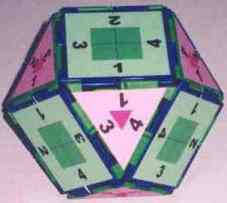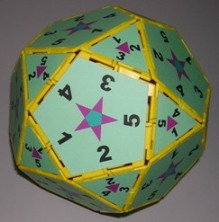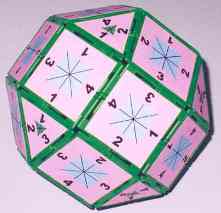The dodecahedron (2) puzzle
This puzzle has 6 natural solutions and 2 equivalence classes that can be distinguished in the following form. Consider two opposite dodecahedron edges. There are other four that are orthogonal to these two. The six edges are over the faces of a virtual cube where the dodecahedron is inscribed. There are five such cubes. The first equivalence class (with only one element / natural solution, see Symmetry / Simetria (9)) has the same number associated to the edges that belong to the faces of each cube. The second equivalence class (with five elements / natural solutions) has the same number associated to the edges that belong to the faces of one of the fives cubes.
The first class group is of order 120 and the second class group is of order 24.
The first class group is of order 120 and the second class group is of order 24.
 In this first photo: the right hand side is obtained from the left hand side using the permutation (123) of the numbers
In this first photo: the right hand side is obtained from the left hand side using the permutation (123) of the numbers In this second photo: the right hand side is obtained from the left hand side using the permutation (25)(34) of the numbers
In this second photo: the right hand side is obtained from the left hand side using the permutation (25)(34) of the numbers In this third photo: the right hand side is obtained from the left hand side using the permutation (12354) of the numbers
In this third photo: the right hand side is obtained from the left hand side using the permutation (12354) of the numbers In this fourth photo: the right hand side is obtained from the left hand side using the permutation (12345) of the numbers
In this fourth photo: the right hand side is obtained from the left hand side using the permutation (12345) of the numbersIn this fifth photo: the right hand side is obtained from the left hand side using the permutation (123) of the numbers
In each of these photos one can see two of the six natural solutions of the dodecahedron (2) puzzle. These solutions are easily recognized because they have the number 2 (solution in the l.h.s.) and the number 3 (solution in the r.h.s) assigned to orthogonal edges.





.jpg)
.jpg)
.jpg)


.jpg)
.jpg)






No comments:
Post a Comment